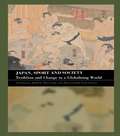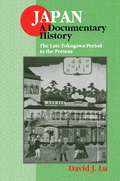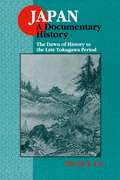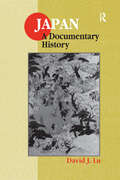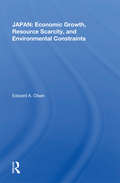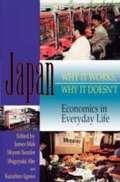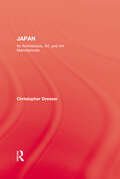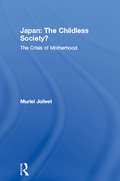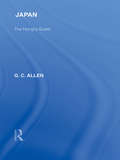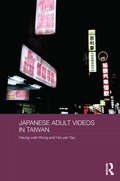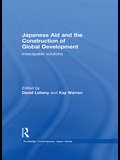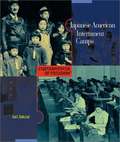- Table View
- List View
Japan, Race and Equality: The Racial Equality Proposal of 1919 (Nissan Institute/Routledge Japanese Studies)
by Naoko ShimazuThis study explores the Japanese motivations in raising the proposal for racial equality at the 1919 Paris Peace Conference. This is the first comprehensive analysis of an historically significant event which has not been given adequate scholarly attention in the past. The story which unfolds underlines the complexity of politics and diplomacy surrounding the racial equality proposal and analyses the effect of the failure of the proposal on Japan's politics in the 1920s and 1930s.
Japan, Russia and their Territorial Dispute: The Northern Delusion (Routledge Contemporary Japan Series)
by James D. BrownThe territorial dispute between Japan and Russia over four islands off the northeast coast of Hokkaidō has been an enduring obstacle to closer relations between the two powers and therefore an important determinant of geopolitics in North-East Asia. Having emerged at the end of World War II, this conflict has now existed for more than seven decades. And yet, despite the passage of so much time, within Japan there remains a resilience of belief that the islands will eventually be returned. This book provides a comprehensive analysis of Japan’s prospects of ever recovering these "Northern Territories". Offering an in-depth account of why the Japanese side believe they still have a chance of securing the return of the four islands, it also provides an objective and methodical evaluation of the prospects of these expectations being realised. The key finding is that Japanese policymakers and scholars have consistently overestimated the extent of Japan’s leverage with regard to Russia, and that there is, in fact, already no possibility whatsoever of sovereignty over the four islands being restored to Japan. This has major implications for Japanese decision makers who must balance their principled commitment not to compromise on territorial issues with more pragmatic considerations of energy security and how to contain the rise of Chinese regional power. Presenting a unique analysis and a strikingly different perspective on this territorial dispute, the findings of this book are of considerable importance for international relations within the Asia-Pacific region. It will be of interest to students and scholars of Japanese Politics, Russian Politics and International Relations.
Japan, Sport and Society: Tradition and Change in a Globalizing World (Sport in the Global Society)
by Joseph Maguire Masayoshi NakayamaEvolving for centuries in relative isolation, sport in Japan developed a unique character reflective of Japanese culture and society. In recent decades, Japan's drive towards cultural and economic modernization has consciously incorporated a modernization of its sports cultures. Japan, Sport and Society provides insights into this process, revealing the tensions between continuity and change, tradition and modernity, the local and the global in a culture facing the new economic and political realities of our modern world. The book explores three broad areas of interest: sport and modern society in Japan current issues in social reconstruction and reproduction in sport modernization, globalization and sport in Japan. Providing unprecedented access to new work from Japanese scholars, and raising key questions of globalization and cultural identity, this text represents a fascinating resource for students and researchers of sport and society.
Japan-Bashing: Anti-Japanism since the 1980s (Routledge Contemporary Japan Series)
by Narrelle MorrisThe aim of this book is to examine and analyse the phenomenon of ‘Japan-bashing’, from its invention and popularisation in the United States in the late 1970s to the emergence of other national variants, including in Australia and Japan, to its gradual decline in the late 1990s. It is the first major book-length study of ‘Japan-bashing from a multinational perspective, one that attempts to place ‘Japan-bashing’ in its proper historical context and to examine its operation and legacy in the twenty-first century. Despite its importance in the study of discourses about Japan, as well as in understanding broader global changes in the late twentieth century and beyond, the phenomenon of ‘Japan-bashing’ remains largely neglected in published writings. Moreover, it is a far more complex phenomenon than has been assessed thus far. While, on first glance, ‘Japan-bashing’ merely seems to recall other periods in which Japan has been viewed as a dangerous ‘other’ to ‘the West’, such as the Western emphasis on the ‘yellow peril’ from the late nineteenth century as well as Allied anti-Japanese propaganda during World War II, ‘Japan-bashing’ also had its own distinctive characteristics. Moreover, while ‘Japan-bashing’ is often described as a quaint historical, rather than a pressing contemporary, phenomenon, it is actually by no means extinct. The ongoing influence of ‘Japan-bashing’ also has parallels in other ‘bashing’ phenomena, such as ‘China-bashing’. This book will be of interest to scholars and postgraduate students in Japanese studies and international relations.
Japan: A Documentary History
by David J. LuAn updated edition of David Lu's acclaimed "Sources of Japanese History", this two volume book presents in a student-friendly format original Japanese documents from Japan's mythological beginnings through 1995. Covering the full spectrum of political, economic, diplomatic as well as cultural and intellectual history, this classroom resource offers insight not only into the past but also into Japan's contemporary civilisation. This volume covers from the late 18th century up to 1995. Three major criteria used in the document selection were that: the selection avoids duplication with other collections - 75% of the documents presented here are newly translated; a document accurately reflects the spirit of the times and the life-styles of the people; and emphasis is on the development of social, economic and political institutions.
Japan: A Documentary History
by David J. LuAn updated edition of David Lu's acclaimed "Sources of Japanese History", this two volume book presents in a student-friendly format original Japanese documents from Japan's mythological beginnings through 1995. Covering the full spectrum of political, economic, diplomatic as well as cultural and intellectual history, this classroom resource offers insight not only into the past but also into Japan's contemporary civilisation. This volume covers up to the late 18th century. Three major criteria used in the document selection were that: the selection avoids duplication with other collections - 75% of the documents presented here are newly translated; a document accurately reflects the spirit of the times and the life-styles of the people; and emphasis is on the development of social, economic and political institutions.
Japan: A Documentary History
by David J. LuAn updated edition of David Lu's acclaimed "Sources of Japanese History", this book presents in a student-friendly format original Japanese documents from Japan's mythological beginnings through 1995. Covering the full spectrum of political, economic, diplomatic as well as cultural and intellectual history, this classroom resource offers insight not only into the past but also into Japan's contemporary civilisation. Three major criteria used in the document selection were that: the selection avoids duplication with other collections - 75% of the documents presented here are newly translated; a document accurately reflects the spirit of the times and the life-styles of the people; and emphasis is on the development of social, economic and political institutions.
Japan: A Documentary History
by David J. LuAn updated edition of David Lu's acclaimed "Sources of Japanese History", this two volume book presents in a student-friendly format original Japanese documents from Japan's mythological beginnings through 1995. Covering the full spectrum of political, economic, diplomatic as well as cultural and intellectual history, this classroom resource offers insight not only into the past but also into Japan's contemporary civilisation. This volume covers up to the late 18th century. Three major criteria used in the document selection were that: the selection avoids duplication with other collections - 75% of the documents presented here are newly translated; a document accurately reflects the spirit of the times and the life-styles of the people; and emphasis is on the development of social, economic and political institutions.
Japan: A Postindustrial Power--third Edition, Revised And Updated (Crowell Comparative Government Ser.)
by Ardath W. BurksJapan has been among the first of the handful of countries to move "beyond modern," and in this third edition of a much-praised book, Ardath Burks brings the blur of the nation's rapid change into focus. In his newly revised and updated Japan, Professor Burks also traces the history of the Japanese, exploring their traditions, their continuity, and their cultural heritage. He devotes a chapter to the remarkable "introspection boom" (Nihonron): the Japanese asking, "Who are we Japanese?" In discussing the country's swift modernization, the author looks not only at the initial transition from primary agriculture to an industrial economy but also at the current evolution into a service-centered society. On both domestic and international levels, the book evaluates the maturing of Japanese industry and its growing investment abroad, as well as the global tensions fueled by Japan's enormous trade surpluses. In response to the intense trade pressure it feels, the country is beginning to shift from export-driven growth to a consumer-oriented economy, a shift that will demand the building of a heretofore neglected, yet essential, infrastructure of housing and transportation. The author analyzes domestic political developments including the regime of Nakasone Yasuhiro and the fall of Takeshita Noboru and Uno Sousuke, precipitated by financial scandal within the majority Liberal Democratic Party (LDP). Burks assesses the formidable tasks facing the revamped ruling LDP as its new generation of younger leaders grapples with an evolving economy, an expanding regional role, and the dissatisfaction of women and young people who have begun to rebel against the growth ethic and their marginalized role in society. In his well-drawn, lucid portrait of this complex country, Professor Burks reflects on Japan as a nation in historical transition, envisioning a postindustrial future filled with friction and promise. As he writes in his introduction, "Americans and Japanese too often look
Japan: Beyond the End of History (Nissan Institute/Routledge Japanese Studies)
by David WilliamsIn this analysis of Japan's policy-making, David Williams places his argument within the debates about Japanese political economy in the United States and Britain, debates previously polarised between `market' and `ministry' views. He presents Japanese-style nationalist development as a serious challenge to Western values and theory.
Japan: Economic Growth, Resource Scarcity, And Environmental Constraints
by Edward A. OlsenThis study evaluates, from a neo-Malthusian perspective, Japan's current status and its prognosis in the context of the country's economic vulnerabilities. Drawing on the theoretical contributions of Malthus, N. Georgescu-Roegen, H. and M. Sprout, and assorted environmental-ecological doomsayers, the author reaches pessimistic conclusions about Japan's very long term prospects, but holds out some slim hope for Japan if international cooperation of nearly Utopian dimensions can be achieved.
Japan: Economics in Everyday Life
by James Mak Shigeyuki Abe Kazuhiro Igawa Shyam SunderAll you could possibly want to know about the Japanese and Japanese economy.
Japan: From Bullet Train To Symbol Of Modern Japan (The Basics #Vol. 5)
by Christopher P. HoodJapan: The Basics, is an engaging introduction to the culture, society and the global positioning of Japan. Taking a fresh look at stereotypes associated with Japan, it provides a well-rounded introduction to a constantly evolving country. It addresses such questions as: • How do we go about studying Japan? • What are the connections between popular culture and wider Japanese society? • How are core values about identity formed and what are their implications? • How does Japan react to natural and manmade disasters? • How does nature influence Japanese attitudes to the environment? With exercises and discussion points throughout and suggestions for further reading, Japan: The Basics is an ideal starting point for all those studying Japan in its global, cultural context.
Japan: Its Architecture, Art, and Art Manufactures
by Christopher DresserFirst Published in 2001. As an architect and ornamentist by profession, the author of this volume has specialist knowledge of many manufacturing processes and presents his observations on architectural edifices and Japanese art. Includes photos and commissioned drawings.
Japan: The Basics (The Basics)
by Christopher P. HoodJapan: The Basics is an engaging introduction to the culture, society, and global positioning of Japan. Starting by looking at the common stereotypes, clichés, and tropes associated with Japan, this accessible introduction to the country is designed to arm readers with key skills and knowledge for their study of Japan. This new edition covers topics including: How do we go about studying Japan? What can be learnt about Japan from looking at its transportation system? What is the impact of an aging society? What are the connections between popular culture and wider Japanese society? How does Japan respond to disasters? How are core values about identity formed and what are their implications? How did Japan respond to the COVID-19 pandemic? With exercises, discussion points, and reflective questions throughout, Japan: The Basics is an ideal starting point for all those studying Japan.
Japan: The Crisis of Motherhood
by Muriel JolivetDisillusioned by long hours at home alone and by demands from the older generation, Japanese women are marrying later, resulting in a sharp decline in the Japanese birth rate. Muriel Jolivet considers the reasons why Japanese women are finding it increasingly difficult to accept the terms and conditions of motherhood.Japan: The Childless Society explores the major factors contributing to maternal malaise in Japan including:* the 'Ten Commandments of the Good Mother'* the changing role of the father* education and careers* nostalgia from older generationsDrawing on extensive interviews with Japanese women and translated into English for the first time, this innovative study examines the implications behind the declining birth rate and looks towards the future of a country that is in danger of becoming a 'childless society'.
Japan: The Hungry Guest
by G C AllenWritten after the outbreak of war between Japan and China but putting aside British sentiments of suspicion, dislike and a sense of competition, G C Allen bases his observations of Japanese social, political and economic life on his first-hand experience of living and working in the country for a number of years. He argues that the economic expansion of Japan was regarded as a greater threat to Britain because of Japan’s political aims and aggressive territorial expansion, but he is at pains to explain the Japanese domestic circumstances which gave rise to this situation. He also argues that the expansion of the British Empire has some parallels with Japanese expansion, without condoning Japanese methods. Overall the author emphasizes the extent to which judgments about the qualities of the Japanese people have been influenced by the political views of writers in Western countries.
Japan: Travel and Researches
by J. J. ReinFirst published in 1884, this remains a compelling and authoritative overview of Japan at the turn of the century. Encompassing physical geography, flora and fauna, history, social conditions, ethnography, and topography, many of the observations in this classic study hold true in modern Japan.
Japanamerica: How Japanese Pop Culture Has Invaded the U. S.
by Roland KeltsJapanamerica is the first book that directly addresses the American experience with the Japanese pop phenomenon, covering everything from Hayao Miyazaki's epics, the burgeoning world of hentai, or violent pornographic anime, and Puffy Amiyumi, whose exploits are broadcast daily on the Cartoon Network, to literary novelist Haruki Murakami, and more. With insights from the artists, critics, readers and fans from both nations, this book is as literate as it is hip, highlighting the shared conflicts as American and Japanese pop cultures dramatically collide in the here and now.For more information visit http://www.japanamericabook.com/
Japanamerica: How Japanese Pop Culture Has Invaded the U.S.
by Roland KeltsContemporary Japanese pop culture such as anime and manga (Japanese animation and comic books) is Asia's equivalent of the Harry Potter phenomenon--an overseas export that has taken America by storm. While Hollywood struggles to fill seats, Japanese anime releases are increasingly outpacing American movies in number and, more importantly, in the devotion they inspire in their fans. But just as Harry Potter is both "universal" and very English, anime is also deeply Japanese, making its popularity in the United States totally unexpected. Japanamerica is the first book that directly addresses the American experience with the Japanese pop phenomenon, covering everything from Hayao Miyazaki's epics, the burgeoning world of hentai, or violent pornographic anime, and Puffy Amiyumi, whose exploits are broadcast daily on the Cartoon Network, to literary novelist Haruki Murakami, and more. With insights from the artists, critics, readers and fans from both nations, this book is as literate as it is hip, highlighting the shared conflicts as American and Japanese pop cultures dramatically collide in the here and now.
Japanese Adult Videos in Taiwan (Routledge Culture, Society, Business in East Asia Series)
by Heung-Wah Wong Hoi-yan YauThis book explores the debate between those who argue that globalisation is leading to worldwide cultural homogeneity, with American cultural good predominating, and those who argue that cultural goods are always adapted and contextualised in the particular setting in which they are used. Based on extensive original research on how Japanese adult videos are consumed in Taiwan, it presents a rich picture of how Japanese adult videos are transformed into something Taiwanese, and how they are incorporated into both male and female Taiwanese sexual culture.
Japanese Aid and the Construction of Global Development: Inescapable Solutions (Routledge Contemporary Japan Series)
by Kay Warren David LehenyInstead of asking the usual questions about Japanese aid — Why is Japanese aid so different from that of other donors? Is Japanese aid effective? — this collection takes it as axiomatic that Japanese aid actors are now working in a contentious environment affected by changing global norms of aid. Japanese Aid and the Construction of Global Development analyses the changing political contexts, both at home and abroad, within which Japanese aid officials develop their programs. It tracks the tensions facing aid officials as they seek to negotiate between a long-term organizational bias in the Japanese government of promoting "growth-oriented" policies, and new demands for Japan to engage a broader array of "human security" concerns. In the third section, contributors provide case studies of new policies designed to cope with transnational human security issues, particularly involving environmental protection, gender equality, and the spread of HIV/AIDS. Finally, the book turns its lens back to Japan with chapters on how changing aid relationships alter Japan’s ability to cope with transnational problems like refugee flows, sex trafficking, and terrorism. This book will be of interest to students and scholars of the politics and culture of global development, Japanese politics and foreign policy, international relations and international law.
Japanese American Celebration and Conflict: A History of Ethnic Identity and Festival, 1934-1990
by Lon KurashigeA history of the struggles over identity within the Japanese American community, using ethnic festivals to reveal the conflicts from the 1930s (a period of wealthy Japanese enclaves) through the WWII internment to the late 20th century influx of investment from Japan.
Japanese American Ethnicity: In Search of Heritage and Homeland Across Generations
by Takeyuki TsudaTraces the contemporary ethnic experiences of Japanese AmericansAs one of the oldest groups of Asian Americans in the United States, most Japanese Americans are culturally assimilated and well-integrated in mainstream American society. However, they continue to be racialized as culturally “Japanese” foreigners simply because of their Asian appearance in a multicultural America where racial minorities are expected to remain ethnically distinct. Different generations of Japanese Americans have responded to such pressures in ways that range from demands that their racial citizenship as bona fide Americans be recognized to a desire to maintain or recover their ethnic heritage and reconnect with their ancestral homeland. In Japanese American Ethnicity, Takeyuki Tsuda explores the contemporary ethnic experiences of Japanese Americans from the second to the fourth generations and the extent to which they remain connected to their ancestral cultural heritage. He also places Japanese Americans in transnational and diasporic context and analyzes the performance of ethnic heritage through the example of taiko drumming ensembles. Drawing on extensive fieldwork with Japanese Americans in San Diego and Phoenix, Tsuda argues that the ethnicity of immigrant-descent minorities does not simply follow a linear trajectory. Increasing cultural assimilation does not always erode the significance of ethnic heritage and identity over the generations. Instead, each new generation of Japanese Americans has negotiated its own ethnic positionality in different ways. Young Japanese Americans today are reviving their cultural heritage and embracing its salience in their daily lives more than the previous generations. This book demonstrates how culturally assimilated minorities can simultaneously maintain their ancestral cultures or even actively recover their lost ethnic heritage.
Japanese American Internment Camps (Cornerstones of Freedom, 2nd Series)
by Gail SakuraiDiscusses the mass relocation of thousands of Japanese Americans during World War II, profiling individuals such as Daniel Inouye, Yoshiko Lchida, and George Takei.


